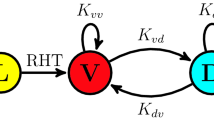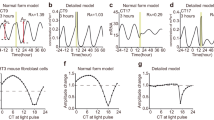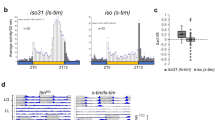Abstract
WINFREE reported 20 years ago the intriguing finding that a light stimulus of a critical strength applied at a critical circadian phase could essentially stop the circadian clock in Drosophila pseudoobscura by resetting the circadian oscillator close to its singularity (a phaseless position at which the amplitude of circadian oscillation is zero)1. Since then, similar observations of attenuated circadian amplitude in response to critical stimuli have been limited to unicells, insects and plants2-7. Our recent demonstration that the phase of the human circadian pacemaker could be inverted using an unconventional three-cycle stimulus8,9 led us to investigate whether critically timed exposure to a more moderate stimulus could drive that oscillator towards its singularity. Here we report that exposure of humans to fewer cycles of bright light, centred around the time at which the human circadian pacemaker is most sensitive to light-induced phase shifts, can markedly attenuate endogenous circadian amplitude. In some cases this results in an apparent loss of rhythmicity, as expected to occur in the region of singularity.
This is a preview of subscription content, access via your institution
Access options
Subscribe to this journal
Receive 51 print issues and online access
$199.00 per year
only $3.90 per issue
Buy this article
- Purchase on Springer Link
- Instant access to full article PDF
Prices may be subject to local taxes which are calculated during checkout
Similar content being viewed by others
References
Winfree, A. T. J. theor. Biol. 28, 327–374 (1970).
Saunders, D. S. J. comp. Physiol. 124, 75–95 (1978).
Engelmann, W. & Johnsson, A. Physiol. Plant 43, 68–78 (1978).
Walz, B. & Sweeney, B. M. Proc. natn. Acad. Sci. U.S.A. 76, 6443–6447 (1979).
Peterson, E. L. J. comp. Physiol. 138, 201–211 (1980).
Taylor, W., Krasnow, R., Dunlap, J. C., Broda, H. & Hastings, J. W. J. comp. Physiol. 148, 11–25 (1982).
Malinowski, J. R., Laval-Martin, D. L. & Edmunds, L. N. J. comp. Physiol. 155, 257–267 (1985).
Czeisler, C. A. et al. Science 244, 1328–1333 (1989).
Strogatz, S. H. J. biol. Rhythms 5, 169–174 (1990).
Winfree, A. T. J. comp. Physiol. 85, 105–140 (1973).
Mills, J. N., Minors, D. S. & Waterhouse, J. M. J. Physiol., Lond. 285, 455–470 (1978).
Winfree, A. T. The Timing of Biological Clocks (Scientific American Books, New York, 1987).
Eskin, A. in Biochronometry (ed. Menaker, M.) 55–80 (National Academy of Sciences, Washington, DC, 1971).
Enright, J. T. & Winfree, A. T. Lect. Math. Life Sci. 19, 121–150 (1986).
Gander, P. H. & Lewis, R. D. Am. J. Physiol. 245, R10–R17 (1983).
Brown, E. N. thesis, 1–116, Harvard Univ. (1987).
Czeisler, C. A. et al. New Engl. J. Med. 322, 1253–1259 (1990).
Kronauer, R. E. in Sleep '90 (ed. Horne, J. A.) 306–309 (Pontenagel, Bochum, 1990).
Author information
Authors and Affiliations
Rights and permissions
About this article
Cite this article
Jewett, M., Kronauer, R. & Czeisler, C. Light-induced suppression of endogenous circadian amplitude in humans. Nature 350, 59–62 (1991). https://doi.org/10.1038/350059a0
Received:
Accepted:
Issue Date:
DOI: https://doi.org/10.1038/350059a0
This article is cited by
-
CARE as a wearable derived feature linking circadian amplitude to human cognitive functions
npj Digital Medicine (2023)
-
Amplitude response and singularity behavior of circadian clock to external stimuli
npj Systems Biology and Applications (2023)
-
Controlling Circadian Rhythms by Dark-Pulse Perturbations in Arabidopsis thaliana
Scientific Reports (2013)
-
Small molecule modifiers of circadian clocks
Cellular and Molecular Life Sciences (2013)
-
Nectar replenishment and pollen receipt interact in their effects on seed production of Penstemon roseus
Oecologia (2009)
Comments
By submitting a comment you agree to abide by our Terms and Community Guidelines. If you find something abusive or that does not comply with our terms or guidelines please flag it as inappropriate.



